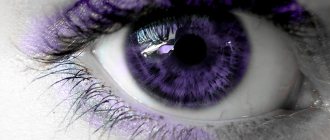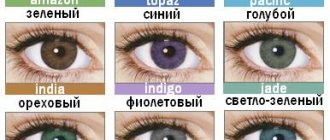Every day we encounter different people. In everyday life, everyone is surrounded by family, work colleagues and just random passers-by.
And each of these people is unique. Hair color, nose shape, height and many other details of the image make the appearance of an individual different from others.
The same applies to the eyes. They have different shapes, cuts and colors. The range of colors in the human iris is very large. Ranging from almost completely transparent in albinos to deep black in African peoples.
What determines eye color
We get a constant eye color almost from birth. But this does not mean that a baby born with dark blue eyes, which happens most often, will remain so. No, usually before the age of three, a child’s eyes can change their shade, lighten, or, on the contrary, darken and become more saturated. This is due to the fact that by these years the melanin content in the body normalizes. It is on this substance, on its greater or lesser concentration in the body, that the color of the eyes, as well as hair, and even the number of moles depends. How much of this substance a person will have directly depends on genetics. A child's appearance is largely determined by how his parents and their ancestors look.
Not everyone is happy with their appearance and not everyone agrees to put up with what they inherited. Almost every one of us at least once would like to change something about ourselves. People everywhere dye and cut their hair, resort to plastic surgery in order to look a little different.
Nowadays it is possible to change the color of the eyes, for example, using colored contact lenses. By using them, you can turn a blue-eyed person into a brown-eyed one and vice versa. But under the lenses the same original color remains. With the help of an operation, brown color can be turned into bright blue, but forever. There is an opinion that there are lucky people who are able to change their eye color without resorting to modern innovations. Can you believe this?
Interesting information
The iris consists of five zones. The color of each depends on the concentration of melanin. If the pigment is concentrated in greater quantities in the outer zone, the iris acquires a brown tint. If melanin is in a very small volume, then the color will be a heavenly tone. It turns out that the shade of the iris directly depends on the influence of various factors that affect the production and concentration of the coloring pigment.
The production and amount of melanin is affected by the functioning of important body systems. The color of the iris can change as a result of pathological conditions that occur in the human body. Moreover, the range of colors is amazing. The iris can change its color from brown to light blue. Chameleon eyes are not genetically transmitted to humans.
Chameleon eyes: truth or myth
Since ancient times, people have attributed magical properties to phenomena that they could not explain. Therefore, a person who did not have a constant eye color was immediately recorded as a magician or witch. Such judgments have given rise to many myths and nonsense. For example, it was believed that if a magician or wizard, looking at a person, changed his eye color, then he cast a spell that would soon bring disaster. Such people were credited with the ability to change not only the color of their eyes, but also their appearance as a whole, and they did not trust them, fearing that they could ruin them.
Of course, this was in the distant past, at a time when science was not yet popular. In those days, people did not believe in such fables.
Life in the twenty-first century dispels such speculation; now everything (or very much) can be explained from a scientific point of view. It is a fact that some people do not have a consistent eye shade. This phenomenon has two forms.
— Firstly, a change in eye color within one shade. That is, the iris can change from light blue to dark blue. This phenomenon is not so noticeable in everyday life. The owner of such a feature may not know about it for a long time. And often, an observant relative or loved one can notice and point out these changes.
You may be interested in Protecting your eyes and vision when watching 3D movies
— Secondly, the shade of the eyes changes dramatically. For example, now the eyes may be gray, a few minutes later green, and in the evening dark gray. This change is hard to miss. And it, of course, can frighten and lead to anti-scientific thoughts. When a person looked with one eye, and a moment later with another, those around him can be seriously embarrassed. And for a moment understand the aborigines who believed in magic.
How does change happen?
Changes in the color of the iris can occur in different ranges. Most often, the tone changes within the same color. This may not be noticed by people who are not aware of such uniqueness.
It may feel like your eye color is changing if there is an ambiguous shade. For example, with a gray-green iris. In this case, people even without chameleon eyes will argue about color. This is due to people's different perceptions of color.
In isolated cases of the phenomenon, the tone can change greatly. For example, turning from dark brown to green or vice versa. This is not done in one day, but over a certain period of time.
Eye color may change with heterochromia. This is when one organ, for example, is green and the other is blue. In some situations the eyes appear to be the same color, while in others one eye changes tone.
Causes of eye color changes
There is no doubt that science and medicine are now well developed even compared to ten or twenty years ago. The progress that these industries have made is amazing. But such a phenomenon as chameleon eyes remains fully studied and partly mysterious. Various experts disagree and cannot accurately explain what causes a change in eye color and why some people experience this phenomenon and others do not. But still, some facts have been compared and some conclusions have been drawn.
Most likely, the change in eye shade in people predisposed to this is influenced by the nervous and endocrine systems. This conclusion can be drawn based on the fact that this phenomenon often occurs in those who have various pathologies of these systems. At present, it is impossible to say whether this skill is innate, inherited, or acquired during life. Although many researchers suggest that, if desired, you can develop this ability yourself. After all, there are techniques with which you can regulate your breathing and heart rate, so why can’t you learn to change the shade of your eyes if it depends on the person?
Eye shade changes depending on light, facial makeup or mood. You can put on, say, a jacket of a different shade, and your chameleon eyes will immediately change shade. In sunny hours, such eyes look lighter than in the evening, and in the same way if a person arrives in a good mood or, conversely, in a bad one.
It should be clarified that the phenomenon of chameleon eyes in itself is not a pathology. People with this feature are not considered unhealthy and do not need therapy. If the eyes change color evenly and under special conditions, and the person does not experience discomfort or pain, then there is no reason for worry or panic. However, if nothing like this has been observed before, and your eyes suddenly begin to change their color, it is better to go to an ophthalmologist in order to exclude and prevent a possible deterioration in health.
Abnormal changes
Heterochromia is a different coloring of the iris, not a disease, so there is no need to worry or be afraid of it.
There is a phenomenon in which one eye of a person differs in color partially or completely from the second. This phenomenon is called heterochromia, or in common parlance cat eyes, is transmitted genetically and manifests itself in one out of a hundred inhabitants of our planet. Celebrities with heterochromia include Kate Bosworth, Demi Moore, Mila Kunis, Alice Eve, Henry Cavill, David Bowie and others.
A sharp change in the color of the iris, which is uncharacteristic for a person, may indicate an illness and, in certain cases, be a symptom of inflammatory processes, traumatic injuries, leukemia and other diseases. To eliminate the possibility of vision deterioration, it is strongly recommended to visit a qualified specialist.
However, there is no need to sound the alarm; a uniform, gradual change in the color of the iris does not mean that a person has dangerous diseases. In most cases, this phenomenon is individual in nature and does not need to be considered as a disease. Many scientists consider the ability to change the shade of the iris to be an acquired human skill, and not a sign of ophthalmic abnormalities.
Features of people with chameleon eyes
There is a theory that states that by a person’s external features one can determine his character, temperament and his characteristic line of behavior. In much the same way as palmists talk about the past and future along the line of life. There are also specialists in this area who, based on external signs, can quite accurately describe his psychological qualities.
You may be interested in People with purple eyes
For example, our facial expressions leave an indelible mark on our face. A smiling person has dimples on his cheeks and nasolabial folds are more pronounced, while in gloomy and angry people, wrinkles leave a characteristic pattern in the upper half of the face. So you can determine the inner world of people by their eyes. But it is worth noting that this theory has not been scientifically proven; it is based on stereotypes accumulated over human history and fairly general assessments.
It’s not for nothing that they say that the eyes are the mirror of the soul. For example, blue-eyed girls are credited with childishness, while brown-eyed young ladies are credited with passion and confidence.
Likewise, people with chameleon eyes have personality traits that match their appearance. These people are dependent on their emotions, they can change and are often impulsive. As changes occur in the color scheme of the iris, so does the line of their behavior, mood, views and statements in different situations.
Basically, women with eyes that can change shade are unstable and multifaceted natures. It is difficult to predict what action such a person will do next. They rarely finish what they start - this is due to the fact that such girls often change priorities and goals, so they rarely achieve their goals. But this also has its advantages - adapting to the changed situation will not be difficult for them. Such girls are easy-going and eagerly embrace new ideas. The ability to quickly adapt to a wide variety of conditions allows them to easily find their place in society and adapt to the people around them. They often try to stay in the shadows, but despite this, they achieve successful results, unlike those who were constantly in the public eye.
Women are more accustomed to listening to their emotions than to logical arguments, and for them such behavior is quite typical and acceptable. But men are often expected to behave differently. Romantic, naive, overly emotional representatives of the stronger sex are considered childish and unreliable. But nevertheless, men with chameleon eyes have such traits.
At the same time, men with chameleon eyes often manage to easily overcome obstacles on the path of life, but their goals are vague and they go in circles. Only occasionally do their actions have a clear sequence, but when a situation arises that requires you to radically change your behavior or make an extraordinary decision, these are the men you can rely on.
Makeup for chameleon eyes
How to choose makeup for a woman whose eye color is unstable? Obviously, this comes with its own difficulties - how to choose eye shadow if the eye color is unstable and they can change it at any moment. The solution is quite simple and obvious.
Shades should be used dim and not too saturated, so as not to take risks. The soft and light color palette of makeup is as versatile as possible. By choosing a hair color from among natural tones, you can base your skin tone on it. This method will allow you to look natural in any situation, because you only need to extract benefit from any of your features.










